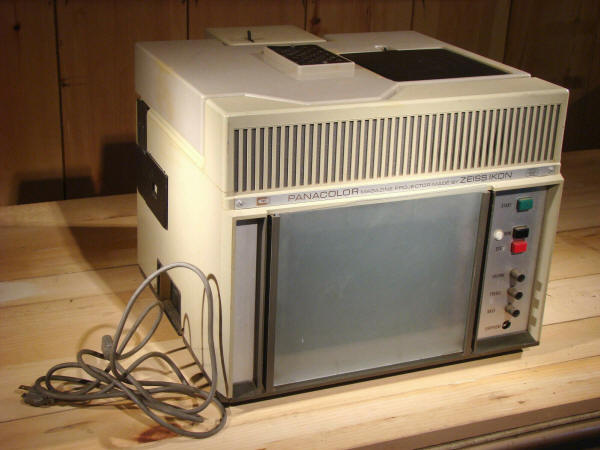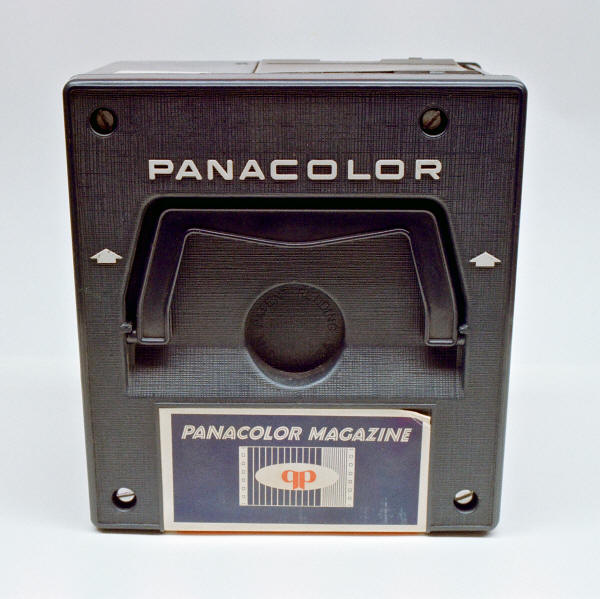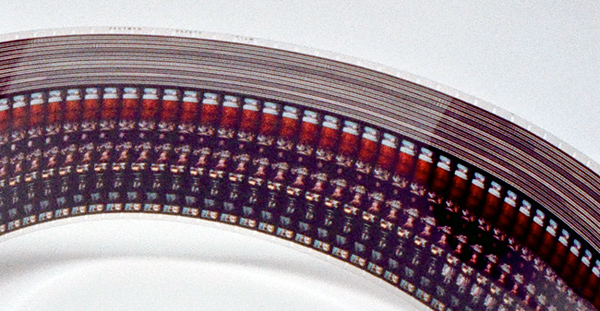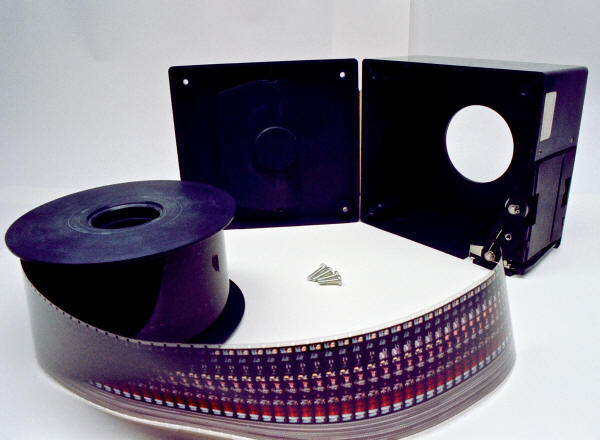Panacolor's "Pik-A-Movie" 70mm System |
This article first appeared in |
| Reprinted from: British Kinematography Sound and Television, August 1973 and supplied by Mr Grant Lobban. |
Issue 54 - September 1998 Updated 22-01-25 |
 Panacolor
sound-movie projector by Zeiss IKON. Just drop the magazine on the spindle,
close the cover, and press the Start button. Picture credit: eBay user:
dosbob (used by permission) Panacolor
sound-movie projector by Zeiss IKON. Just drop the magazine on the spindle,
close the cover, and press the Start button. Picture credit: eBay user:
dosbob (used by permission)The Pik-A-Movie system was invented by Dr Leo W. Wells and developed by Panacolor in which the German company Zeiss is the major shareholder. The system differs in that the cassette contains film and the equipment is shown by optical rear projection to the viewer. Each viewer is delivered his own set when he requests the service and consequently the system can be used in any hotel. This is a considerable advantage when it is realised that only a very small percentage of British Hotels contain a colour television in each room. The cassette used in the system contains 300ft of film and is sufficient for two hours of programme. A single full length feature can be shown, or as many as six different subjects may be programmed in a single cassette measuring 61/2" x 7" x 4" (16,51 x 17,78 x 10,16cm). When operating the machine, facilities are available for repeating sections of the film or for studying a single frame. • Go to PDF A History of Panacolor by Caroline Roll |
Further in 70mm reading: |
 The
Panacolor Pik-A-Movie 70mm cassette
with 70mm film. Picture by Thomas Hauerslev. The
Panacolor Pik-A-Movie 70mm cassette
with 70mm film. Picture by Thomas Hauerslev.A special film process is adopted in producing the films for the cassette. Twelve rows of super-8 sized pictures and twelve tracks of optical sound are printed on a 70mm film as shown. It is, therefore, necessary for the projector to be indexed from one row to another in order to completely show the contents of the magazine. The film is transported through the projector in a horizontal plane and the first row of pictures and sound are projected. At the end of the first row an inaudible tone is superimposed onto the soundtrack which causes the film projector mechanism to step-up one row and reverse the direction of the film. This operation is repeated for the remaining rows of the film: at the end of the twelfth row the film is returned to a start position and the projector is automatically shut-off, leaving the film completely rewound in the magazine. The film is transported at 30 ft (9,144m) per minute and shown at a frame rate of 24 frames per second. It is projected onto a rear projection type screen normally measuring 71/4" x 10" (18,415 x 25,4cm) although this size can be increased to 11" x 16" (27,94 x 40,64cm). The operational controls are simple and in addition to the normal controls for stop, start and volume, the viewer has the facilities for selecting any row of the film and for reversing the direction of the film if required. The system provides a solution for reducing the amount of film required to show a full length movie and substantially reduces the processing cost for producing duplicate prints. The cassette also provides protection against damage normally encountered when the film is handled. The system is obviously adaptable with the correct software to applications other than hotel movies and then it would be entering the same market as EVR. |
|
Reprinted from Journal of the SMPTE, May 1967 |
|
 The
Panacolor Pik-A-Movie 70mm roll of 70mm film. Picture by
Thomas Hauerslev. The
Panacolor Pik-A-Movie 70mm roll of 70mm film. Picture by
Thomas Hauerslev.The Panacolor cartridge, incorporating 10 rows of a modified 8mm format on a 70mm film, uses a cartridge containing up to 350 ft (106,68m) of the 70mm film with a film projection rate of 24 frames/s at 26 ft/min incorporating photographic sound and a left-to-right and vise versa instead of up-and-down transport. The projection unit has been introduced as a rear-screen unit with a direct projection option and incorporates a rotating prism synchronized by means of a sprocket. Each cartridge can contain up to 12 different short subjects, or single-concept films up to 10 minutes running time, with random or successive selection. |
|
Reprinted from Popular Science - Aug 1968 |
|
 The
Panacolor Pik-A-Movie 70mm cassette and roll of 70mm film. Picture by
Thomas Hauerslev. The
Panacolor Pik-A-Movie 70mm cassette and roll of 70mm film. Picture by
Thomas Hauerslev.12-Channel sound-Movie Cassette plays for Two Hours You never touch the film with the Panacolor sound-movie projector — just drop the magazine on the spindle, close the cover, and press the Start button. At the end of the movie, two hours later, the projector shuts off automatically. Don't like to sit through two-hour feature? The magazine can also hold six 20-minute features. You press a button that says "Row" to select the feature you want. Other buttons let you control the sound volume and adjust the treble and bass. A remote control offers forward, reverse, slow motion, frame-at-a-time viewing or stop. The system uses 70mm film, with 12 rows of super-8-size pictures on it. The pictures are turned sideways to get them all on the film. About a quarter of the film width is taken up by 12 double rows of squiggly lines. Those are the optical sound tracks, printed on the film just like the sound track on the film your local movie house uses. The magazine can hold 300 feet of film. The film goes back and forth between two reels: 10 minutes in one direction, 10 minutes back to the starting line. It's projected in both directions. No rewinding is necessary. The projector works as quietly as a tape recorder. That's because it uses the same kind of capstan drive, instead of the usual clickety-click claw that grabs the perforations and pulls the film past the lens. It's easier on the film, too. The projector has its own built-in screen, but can also be used with a standard movie screen. Zeiss-Ikon-VoigtLander makes the projector for Panacolor, Inc., NYC. It's intended for schools, business, and government. But you can have one, too, for $595. Everett H. Ortner. |
|
| Go: back
- top - back issues Updated 22-01-25 |
